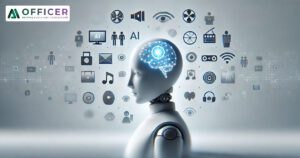
In the fast-paced digital age, businesses are constantly seeking ways to boost productivity and efficiency. One common bottleneck that many organizations face is the time-consuming task of manual data entry. The good news is that artificial intelligence (AI) is stepping in to revolutionize this mundane process, offering innovative solutions that not only save time but also enhance accuracy. Let’s explore how AI is transforming manual data entry into a streamlined and automated powerhouse.
The Manual Data Entry Challenge
Manual data entry is a necessary but tedious task that consumes valuable time and resources. From transcribing handwritten documents to inputting data into spreadsheets, the potential for errors is high, and the process is prone to inefficiencies. As businesses deal with increasing volumes of data, finding a solution to this challenge becomes imperative.
AI-Powered Optical Character Recognition (OCR)
One of the game-changers in automating manual data entry is AI-powered Optical Character Recognition (OCR). This technology enables computers to interpret and convert different types of documents, such as scanned paper documents, PDFs, or images captured by a digital camera, into editable and searchable data.
OCR algorithms, often integrated into document management systems, can accurately extract information from documents, eliminating the need for manual input. This not only accelerates the data entry process but also minimizes the risk of errors inherent in manual transcription.
Natural Language Processing (NLP) for Data Extraction
Natural Language Processing (NLP) is another AI capability making waves in automating manual data entry. NLP enables computers to understand, interpret, and generate human-like text, allowing for the extraction of relevant information from unstructured data sources.
For businesses dealing with a variety of documents, such as contracts, emails, or customer feedback, NLP algorithms can be trained to identify key data points. This ensures that important information is accurately extracted and entered into databases without human intervention, saving both time and resources.
Data Validation and Cleansing with Machine Learning
Inaccurate or incomplete data can lead to significant challenges for businesses. AI, particularly machine learning algorithms, can play a vital role in data validation and cleansing. These algorithms can analyze patterns in the data, identify anomalies, and automatically correct or flag discrepancies.
By implementing machine learning in the data entry process, organizations can maintain a high level of data quality. This not only reduces the risk of errors but also enhances the overall reliability of the information stored in databases.
Automation Through Robotic Process Automation (RPA)
Robotic Process Automation (RPA) takes automation to the next level by employing software robots to mimic the actions of a human interacting with digital systems. In the context of manual data entry, RPA can be applied to automate repetitive tasks such as form-filling, copy-pasting, and data validation.
RPA solutions can be customized to handle specific data entry workflows, allowing businesses to automate mundane tasks without the need for complex coding. This not only accelerates the data entry process but also frees up human resources to focus on more strategic and creative aspects of their roles.
Benefits Beyond Efficiency: Accuracy and Scalability
The advantages of implementing AI in manual data entry go beyond mere efficiency gains. The accuracy achieved through AI-powered solutions significantly reduces the likelihood of errors that can have costly consequences for businesses. Moreover, the scalability of these solutions means they can handle large volumes of data seamlessly, adapting to the growing needs of an organization.
Considerations and Future Outlook
While the benefits of AI in automating manual data entry are evident, it’s crucial for businesses to consider factors such as data security, privacy, and the ethical use of AI technologies. As AI continues to evolve, we can expect even more sophisticated solutions, perhaps incorporating elements of artificial general intelligence (AGI) that can adapt to diverse data entry tasks.
In conclusion, the era of being stuck in manual data entry is coming to an end, thanks to the transformative power of AI. From OCR and NLP to machine learning and RPA, businesses now have a diverse set of tools at their disposal to automate mundane tasks and unlock new levels of efficiency.
Embracing these AI solutions not only accelerates processes but also empowers organizations to make better-informed decisions based on accurate and reliable data. The future of data entry is intelligent, automated, and driven by the limitless possibilities of artificial intelligence.
Get the latest AI insights from AI Officer. For podcasting entrepreneurs eager to leverage AI, our experienced officers are at your service. We’re committed to powering your success with AI.




